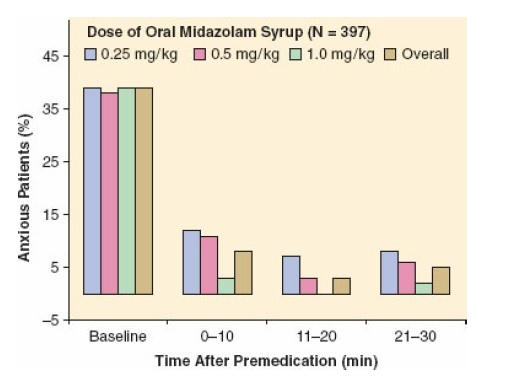Using Midazolam for Sedation and Premedication
Midazolam, a benzodiazepine, is currently the drug most commonly used to reduce preoperative anxiety and induce sedation. It can be administered intravenously and orally. In adults, it can be used to control preoperative anxiety and, during a procedure alone or in combination with other drugs, for intravenous sedation. For children, oral midazolam in doses as small as 0.25 mg/kg
produces effective sedation and reduces anxiety. With this dose, most children can be effectively separated from their parents after 10 minutes and satisfactory sedation can be maintained for 45 minutes. Some children, particularly younger and more anxious children, even when they receive midazolam 0.5 mg/kg, show signs of distress. Discharge may be delayed when midazolam is given before a short procedure. Oral diazepam is useful to control anxiety in adult patients, either the day before surgery or the day of surgery and before intravenous line insertion.Sleepiness associated with the effects of anxiolytics may delay or prevent the discharge of patients on the day of surgery, although more frequently patients are admitted because of the effects of the operation. With regard to anesthesia effects, patients more frequently stay in the facility not because they are too sleepy but because they are nauseous. In adults, particularly when midazolam is combined with fentanyl, patients can remain sleepy for up to 8 hours. Although children may be sleepier after oral midazolam, discharge times are not affected.
At proper doses, neither midazolam nor diazepam place patients at any additional risk for cardiovascular and respiratory depression. Decreased oxygen saturation has been reported after injection of midazolam. Routine administration of supplemental oxygen with or without continuous monitoring of arterial oxygenation is recommended whenever benzodiazepines are given intravenously. This precaution is important not only when midazolam is given as a premedicant but also when it is used alone or with other drugs for conscious sedation. The potential for amnesia after premedication is another concern, especially for patients undergoing ambulatory surgery. Anterograde but probably not retrograde amnesia occurs. For benzodiazepines, the effects on memory are separate from the effects on sedation. In addition, amnesia is not simply an effect of drug administration but, among other factors, it is also a function of stimulus intensity.
J. LANCE LICHTOR • PETER MANCINI


